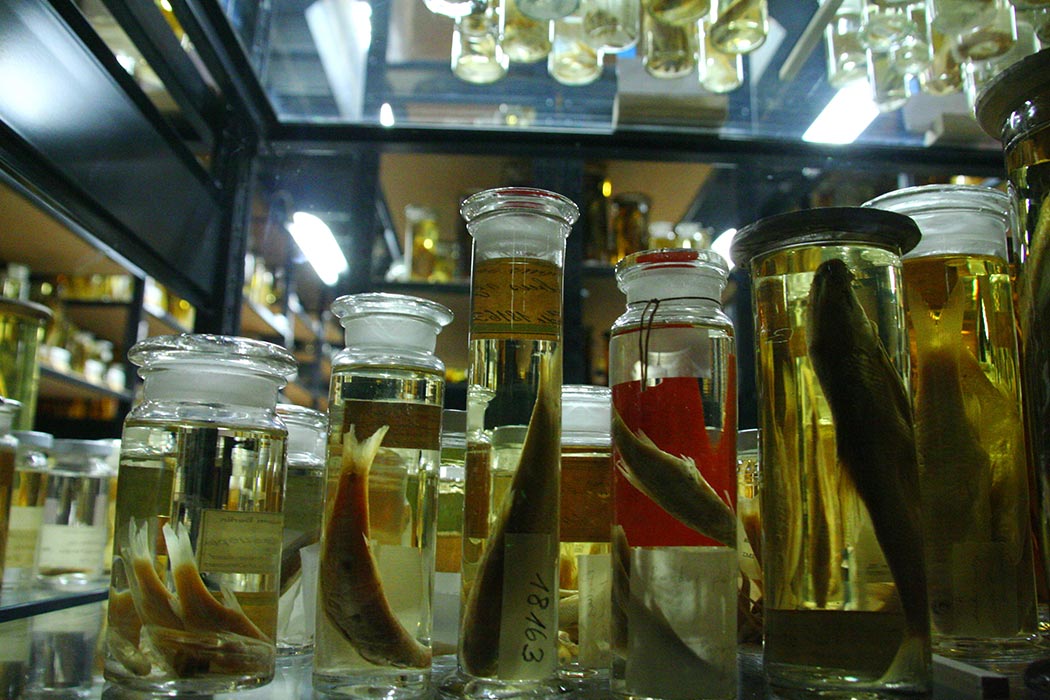Among the many part-time jobs I held in college, my favorite might have been the semester I spent as a fish librarian. The fish library was a vast series of underground rooms below a natural history museum. Each room housed an array of 70s-style modular shelves, and each shelf was packed with dusty jars. The jars contained fish, suspended in a variety of chemical preservatives, who pressed their dead eyes against the glass.
The eerie, Harry Potter-esque sensation of walking between floor-to-ceiling rows of dead fish never quite wore off, although the job itself was relatively mundane. I jarred new fish brought in from deep-sea collecting trips, re-jarred old ones whose preservatives had evaporated or leaked out, and made sure the jars were filed correctly, with no species taking up more shelf space than needed. Most often, I wheeled a squeaky cart from room to room, collecting specimens to be sent out to fish researchers at museums and universities, and re-shelved specimens recently returned from far-flung voyages.
My stint at the fish library was my first glimpse into the fascinating world of natural history collections. The carefully curated contents of the public museum are often only the tip of the iceberg. Beneath museum floors lie storehouses of material that exist outside the public limelight, visible only upon request. Rather than becoming obsolete, these collections only grow more valuable to scientists over time, as new technologies improve our ability to mine data from historical samples.
Specimen collections have long formed a basis for the study of zoology. However, their use in wildlife conservation is a bit more recent—and perhaps more surprising. Paradoxically, long-dead animals may offer us the keys to conserving live ones.
Disease ecology was one of the earliest fields to recognize the value of historical collections for conservation. Diseases often exist undetected long before they are officially recognized, meaning that reconstructing their emergence requires some historical sleuthing. By associating spikes in disease rates with things like local climate, population distribution, and land use, conservationists have a better shot at identifying the factors behind disease epidemics and figuring out how they might be contained. As early as 1886, the British Medical Journal was reporting on how bacteria in museum specimens could be used to understand the emergence and spread of diseases. More recently, improvements in DNA sequencing allowed epidemiologists to trace the emergence of Lyme disease in ticks and mice. Specimen collections have also helped to map the emergence and spread of parasitic diseases that cause widespread malformation and death in amphibians. The collections show that mass malformations existed long before the disease began wiping out entire populations, but that the frequency of these mass-death events has increased in recent decades.
Along the same lines, the effects of human activity are often present long before they become visible. Just as the Anthropocene era has left its thumbprint on the earth’s geology, environmental pollutants leave permanent traces on the hair, feathers, shells, and bones of museum specimens. Even small amounts of material can reveal how environmental levels of heavy metals and other contaminants have changed over time. In 1966, a team of Swedish researchers amassed a century’s worth of data on mercury content in bird feathers. They connected the use of mercury-based agricultural fungicides with an unprecedented spike in mercury exposure. The findings led directly to a ban on the fungicide. On a broader scale, patterns from albatross feathers have revealed that, even in remote parts of the world, animals are affected by changes in distant industrial practices and the contaminants they produce. In one recent study, a team of scientists suggested that wolves are “better than tree rings” as a record of historical changes in atmospheric carbon.
Efforts to delve into the lives of ancient and even extinct species have been aided by the ability to extract more information from less material, and some of the most exciting techniques that have emerged in recent years have focused on using tissues from animal specimens. Since animals must build their tissues from what they consume, our diets—both what foods we eat and where those foods come from—also leave permanent traces. The field of stable isotope analysis uses subtle differences in molecules as signatures of their environments and sources, allowing researchers to explore how diets and species movements have changed over time. Stress hormones also show up in tissues, providing clues as to how other changes might have affected individual behavior and health. These techniques are relatively new, but promise a future in which we might reconstruct the workings of distant ecosystems from a single feather.
In the fish library, I once read a letter that the curator received in the 1920s from a middle schooler conducting a science fair project. She had heard that freezing her goldfish would keep it alive forever, in a sort of cryogenic slumber, and was wondering if the museum curators could give her any advice. The response was gentle but negative, and we still haven’t figured out the secret. In a way, though, she had the right idea: There are plenty of secrets stored in suspended animation beneath our museums, provided we can figure out how to listen.







